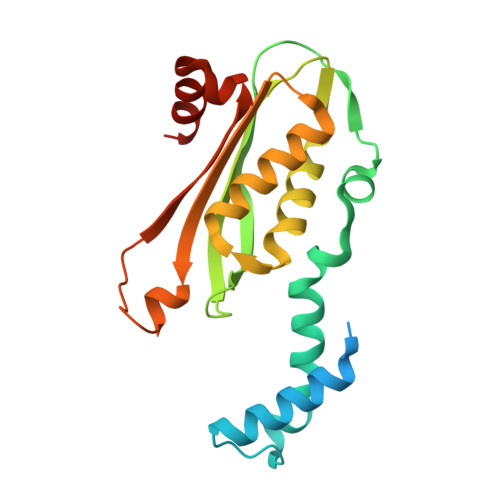Novel reaction mechanism of GTP cyclohydrolase I. High-resolution X-ray crystallography of Thermus thermophilus HB8 enzyme complexed with a transition state analogue, the 8-oxoguanine derivative
Tanaka, Y., Nakagawa, N., Kuramitsu, S., Yokoyama, S., Masui, R.(2005) J Biochem 138: 263-275
- PubMed: 16169877
- DOI: https://doi.org/10.1093/jb/mvi120
- Primary Citation of Related Structures:
1WM9, 1WUQ, 1WUR - PubMed Abstract:
GTP cyclohydrolase I (GTPCH1) catalyzes the conversion of GTP to dihydroneopterin 3'-triphosphate. We found that an 8-oxoguanine derivative of GTP (8-oxo-GTP) strongly bound to GTPCH1 from Thermus thermophilus HB8 (tGTPCH1) as a competitive inhibitor. The affinity of 8-oxo-GTP was three orders of magnitude greater than that of GTP. These results suggest that 8-oxo-GTP is a transition state analogue of GTPCH1. We have solved the X-ray crystal structures of tGTPCH1 complexed with 8-oxo-GTP and 8-oxo-dGTP at 2.0 and 1.8 A resolution, respectively, as well as the free form of the enzyme at 2.2 A resolution. In the structure of tGTPCH1 complexed with 8-oxo-GTP or 8-oxo-dGTP, the oxygen atoms at O8 of the 8-oxoguanine groups, together with residues Cys108, His111 and Cys179, are coordinated to the zinc ion. The water molecule between Ndelta1 of His177 and N7 of 8-oxoguanine is conserved in both structures. These structural data are in accordance with one of the proposed transition states. Superimpositioning of the structures indicates the imidazole ring of His110 is rotated, implying concomitant proton transfer to the ribose ring O4'. Based on these structural data we propose a novel reaction mechanism for GTPCH1.
Organizational Affiliation:
Department of Biology, Graduate School of Science, Osaka University, 1-1 Machikaneyama-cho, Toyonaka, Osaka 560-0043, Japan.
















